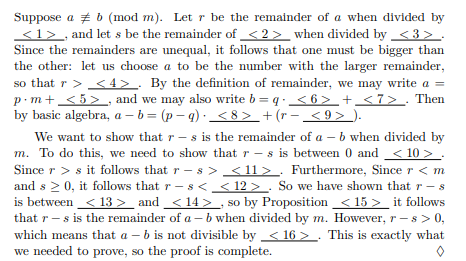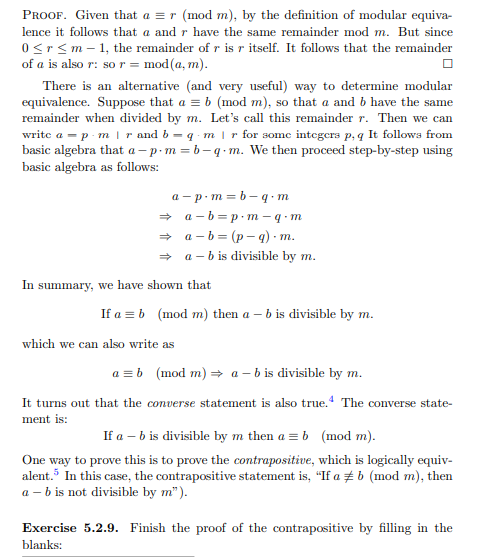Suppose a # b (mod m). Let r be the remainder of a when divided by <1> , and let s be the remainder of < 2 > _when divided by <3 > . Since the remainders are unequal, it follows that one must be bigger than the other: let us choose a to be the number with the larger remainder, so that r > <4> . By the definition of remainder, we may write a = p · m+ < 5> , and we may also write b = q. < 6> + <7> . Then by basic algebra, a– b = (p – q) ·<8 > + (r- <9> ). We want to show that r - s is the remainder of a – b when divided by m. To do this, we need to show that r - s is between 0 and < 10 > . Since r > s it follows that r – s > <11> . Furthermore, Since r 0, it follows that r-s< _ < 12 > . So we have shown that r - s is between < 13 > and<14> that r- s is the remainder of a – b when divided by m. However, r – s> 0, which means that a – b is not divisible by_ < 16 >. This is exactly what we needed to prove, so the proof is complete. , so by Proposition <15 > _ it follows
Suppose a # b (mod m). Let r be the remainder of a when divided by <1> , and let s be the remainder of < 2 > _when divided by <3 > . Since the remainders are unequal, it follows that one must be bigger than the other: let us choose a to be the number with the larger remainder, so that r > <4> . By the definition of remainder, we may write a = p · m+ < 5> , and we may also write b = q. < 6> + <7> . Then by basic algebra, a– b = (p – q) ·<8 > + (r- <9> ). We want to show that r - s is the remainder of a – b when divided by m. To do this, we need to show that r - s is between 0 and < 10 > . Since r > s it follows that r – s > <11> . Furthermore, Since r 0, it follows that r-s< _ < 12 > . So we have shown that r - s is between < 13 > and<14> that r- s is the remainder of a – b when divided by m. However, r – s> 0, which means that a – b is not divisible by_ < 16 >. This is exactly what we needed to prove, so the proof is complete. , so by Proposition <15 > _ it follows
Algebra & Trigonometry with Analytic Geometry
13th Edition
ISBN:9781133382119
Author:Swokowski
Publisher:Swokowski
Chapter10: Sequences, Series, And Probability
Section10.4: Mathematical Induction
Problem 8E
Related questions
Question
Please do Exercise 5.2.9

Transcribed Image Text:Suppose a # b (mod m). Let r be the remainder of a when divided by
<1> , and let s be the remainder of < 2 > _when divided by <3 > .
Since the remainders are unequal, it follows that one must be bigger than
the other: let us choose a to be the number with the larger remainder,
so that r > <4> . By the definition of remainder, we may write a =
p · m+ < 5> , and we may also write b = q. < 6> + <7> . Then
by basic algebra, a– b = (p – q) ·<8 > + (r- <9> ).
We want to show that r - s is the remainder of a – b when divided by
m. To do this, we need to show that r - s is between 0 and < 10 > .
Since r > s it follows that r – s > <11> . Furthermore, Since r <m
and s > 0, it follows that r-s< _ < 12 > . So we have shown that r - s
is between < 13 > and<14>
that r- s is the remainder of a – b when divided by m. However, r – s> 0,
which means that a – b is not divisible by_ < 16 >. This is exactly what
we needed to prove, so the proof is complete.
,
so by Proposition <15 > _ it follows

Transcribed Image Text:PROOF. Given that a =r (mod m), by the definition of modular equiva-
lence it follows that a and r have the same remainder mod m. But since
0<r<m – 1, the remainder of r is r itself. It follows that the remainder
of a is also r: so r = mod(a, m).
There is an alternative (and very useful) way to determine modular
equivalence. Suppose that a = b (mod m), so that a and b have the same
remainder when divided by m. Let's call this remainder r. Then we can
write a = p- m | r and b = q - m | r for some integers p, q It follows from
basic algebra that a – p- m = b-q · m. We then proceed step-by-step using
basic algebra as follows:
e
a - p. m = b– q · m
+ a- b= p.m - q. m
а -b3 (р-4) - т.
+ a - b is divisible by m.
In summary, we have shown that
If a = b (mod m) then a – b is divisible by m.
which we can also write as
a =b (mod m) = a - b is divisible by m.
It turns out that the converse statement is also true. The converse state-
ment is:
If a – b is divisible by m then a = b (mod m).
One way to prove this is to prove the contrapositive, which is logically equiv-
alent. In this case, the contrapositive statement is, "If a # b (mod m), then
a - b is not divisible by m").
Exercise 5.2.9. Finish the proof of the contrapositive by filling in the
blanks:
Expert Solution
Step 1

Step by step
Solved in 2 steps with 2 images

Recommended textbooks for you

Algebra & Trigonometry with Analytic Geometry
Algebra
ISBN:
9781133382119
Author:
Swokowski
Publisher:
Cengage

Elements Of Modern Algebra
Algebra
ISBN:
9781285463230
Author:
Gilbert, Linda, Jimmie
Publisher:
Cengage Learning,

Algebra & Trigonometry with Analytic Geometry
Algebra
ISBN:
9781133382119
Author:
Swokowski
Publisher:
Cengage

Elements Of Modern Algebra
Algebra
ISBN:
9781285463230
Author:
Gilbert, Linda, Jimmie
Publisher:
Cengage Learning,